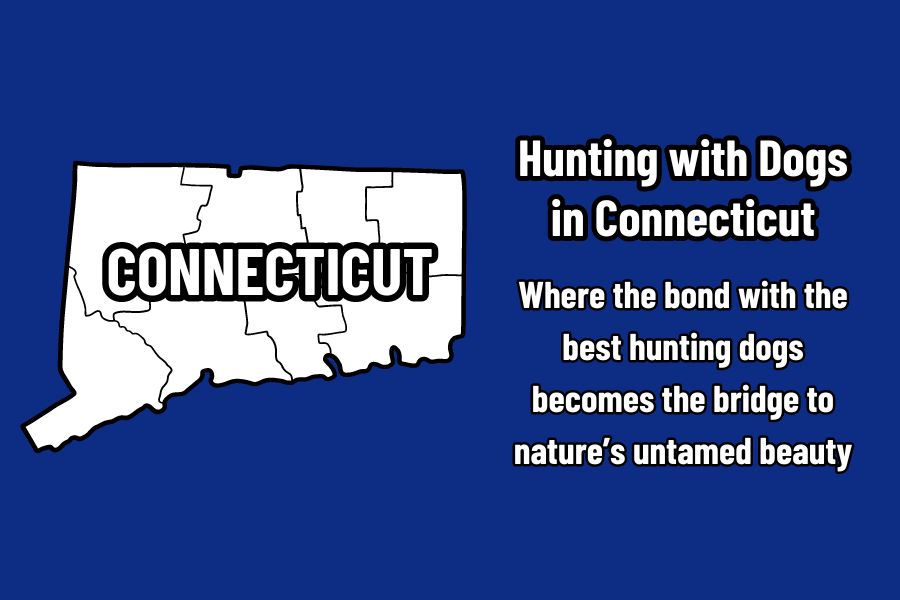Discover the thrill of hunting with dogs in Connecticut with our comprehensive guide. Whether you’re a seasoned hunter or just starting out, find essential tips on regulations, game species, and more to ensure a successful hunting experience. Join our community of passionate hunters!
Introduction
Ever felt the pulse of the wild, the quiet rustle before the chase begins? That’s the heart of hunting with dogs in Connecticut. It’s not just a sport; it’s a tradition, where every call and response thrills the soul. You get it, right? The early mornings, the whisper of the forest and bonding with the best hunting dogs promises a new and exciting adventure.
Whether you’re the seasoned hunter who knows the woods like the back of your hand or the eager novice with eyes wide with wonder, hunting with dogs in Connecticut offers a unique call to the wild. Are you ready to learn about the best species to hunt, their habitats and some important hunting traditions in Connecticut?
Let’s begin this journey together, where tradition meets passion, and every hunt tells a new story.
Understanding Connecticut Hunting Regulations with Dogs
Navigating through the complexities of Connecticut hunting regulations can seem daunting, but understanding these laws is crucial for anyone involved in hunting with dogs in Connecticut. The regulations are designed to balance the tradition of hunting with conservation and animal welfare principles. Clear guidelines dictate what is permissible, ensuring both hunter and animal safety.
Hunting Big Game in Connecticut
In Connecticut, big game hunting with dogs has specific restrictions. The laws explicitly prohibit using dogs to hunt deer, reflecting an ethical stance on fair chase principles. Similarly, bear hunting is not allowed, with the only exception being immediate self-defense. Moose hunting is also off-limits, with stringent penalties, including fines and potential imprisonment, for those who disregard this regulation.
Hunting Small Game, Upland Game Birds, Waterfowl, and Furbearers in Connecticut
For smaller game and various birds, dogs play a pivotal role, enhancing the hunting experience. They are permitted to engage in activities like chasing, cornering, retrieving, flushing, or pointing, except in turkey hunting. However, during the fall firearms season, dogs can be used for turkey hunting only on private property, showcasing the detailed nuances of the state’s hunting laws.
Dogs are an Integral Part of Hunting in Connecticut
The tradition of hunting with dogs in Connecticut is alive and well. Designated Dog Training Areas provide a space for young hunting dogs to develop their skills. These areas allow for live-bird training, aligning with the open hunting season for lawful bird hunting. Additionally, the state hosts numerous hunting dog trials, which assess the dogs’ hunting abilities and showcase the extensive training invested in preparing them for these competitions.
Hunting Deer In Connecticut
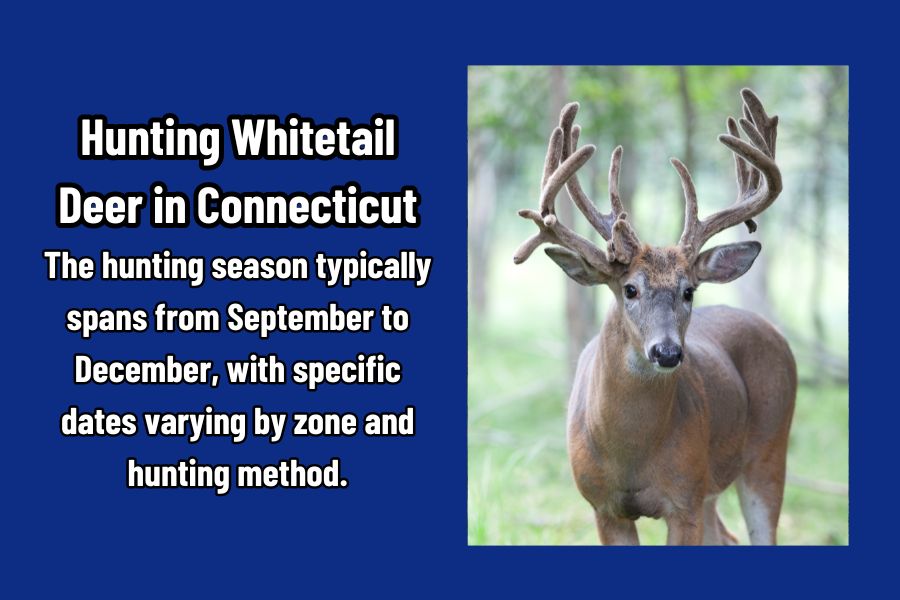
Deer hunting in Connecticut is a popular activity, drawing enthusiasts to the diverse habitats that range from coastal marshes to upland forests. The state primarily hosts Whitetail deer, known for their adaptability and presence throughout Connecticut. The hunting season typically spans from September to December, with specific dates varying by zone and hunting method.
Licenses and Legal Tips
Licenses are required, and hunters must adhere to tag limits and zone regulations. Intriguingly, Connecticut has seen a significant increase in deer populations over the decades, leading to more liberal harvest regulations to manage their numbers effectively. It’s important to note that hunting with dogs in Connecticut for deer is strictly prohibited within the state. This regulation is in place to ensure a fair chase and to minimize stress on the deer population.
Hunters must also be aware of legal considerations, such as respecting private property boundaries and understanding public land restrictions. The state provides detailed maps and resources to help hunters plan their outings responsibly and ethically.
Whitetail Deer
The Whitetail deer, Connecticut’s primary game species, is renowned for its keen senses and elusive nature. These deer are not only a favorite among hunters for their challenging pursuit but also for their significant role in the state’s ecosystem and hunting culture. Whitetail deer have a varied diet, which allows them to thrive in the mixed landscapes of Connecticut, from dense forests to suburban fringes.
Their population dynamics are closely monitored to ensure sustainable hunting practices. Hunters aiming for Whitetail deer must familiarize themselves with the animal’s behavior and habitat preferences, enhancing their chances for a successful hunt while adhering to the state’s wildlife conservation goals.
Small Game Hunting In Connecticut
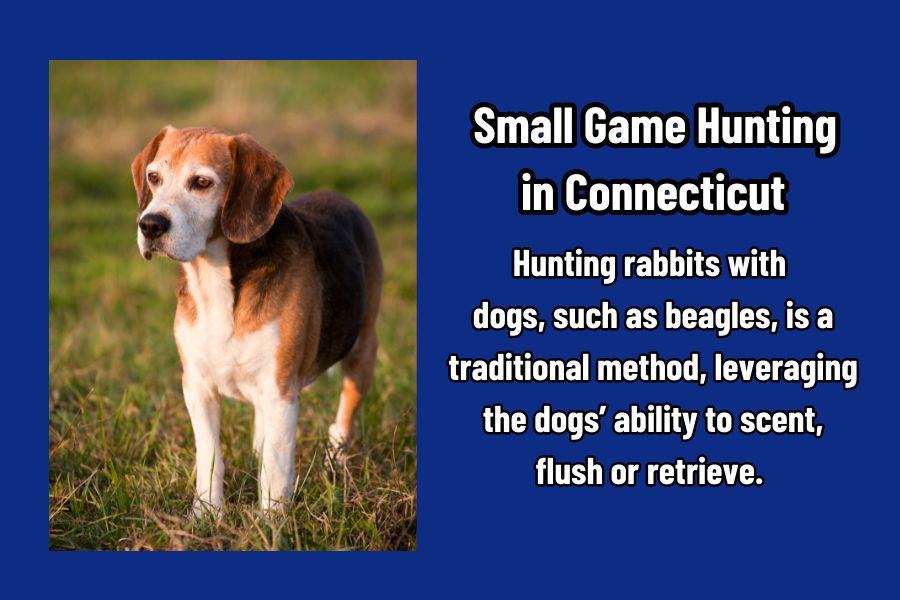
Small game hunting in Connecticut offers a variety of opportunities for hunters to engage with the natural environment and test their skills. The state’s diverse habitats, from dense woodlands to open fields, are home to several small game species, each with its own hunting season and licensing requirements. Hunting with dogs in Connecticut play a crucial role in small game hunting. Dogs can assist in flushing out, tracking, or retrieving game, enhancing the hunting experience through their keen senses and agility.
Hunting Squirrel in Connecticut – Gray Squirrel
Gray squirrels, with their bushy tails and agile movements, are a common sight in Connecticut’s hardwood forests and suburban areas. The squirrel hunting season typically runs from September to January, offering a lengthy period for hunters to participate. Licenses are required, and hunters must adhere to daily bag limits. Dogs can be especially useful in locating and treeing squirrels, making them invaluable companions for this type of hunting. Intriguingly, gray squirrels have excellent memory for locating their cached food, which adds an interesting twist to hunting them as they navigate through the forest’s tree tops.
Hunting Rabbit in Connecticut – Cotton Tail, Snowshoe Hare, European Hare
Connecticut’s rabbit hunting features species like the Eastern Cottontail, Snowshoe Hare, and less commonly, the European Hare. These rabbits have distinct habitats; cottontails favor brushy fields and hedgerows, while snowshoe hares are found in higher elevation forests, adapting with white winter coats. Rabbit hunting season usually falls in the cooler months, from October to February. Hunting rabbits with dogs, such as beagles, is a traditional method, leveraging the dogs’ ability to scent and flush out rabbits, providing a dynamic hunting experience. The intelligence and speed of these rabbits, especially the snowshoe’s ability to traverse snowy terrains, present a rewarding challenge for hunters.
Hunting Woodchuck in Connecticut
Woodchucks, or groundhogs, are typically hunted not for sport but for managing their population and mitigating land damage. Found across Connecticut’s fields and meadows, woodchuck hunting doesn’t have a specific season but is regulated by state wildlife management laws. While dogs are not traditionally used for hunting woodchucks, they can be effective in locating and alerting hunters to their burrows. The woodchuck’s ability to create extensive underground networks makes hunting them both a necessity for landowners and an interesting pursuit for hunters, highlighting the practical aspect of small game hunting in Connecticut.
Furbearer Hunting in Connecticut
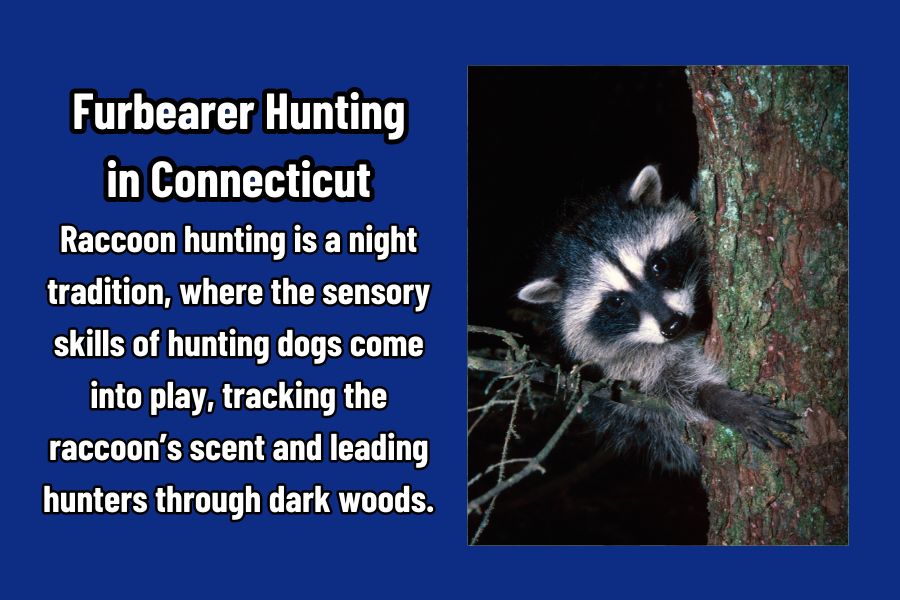
Furbearer hunting in Connecticut is an important part of our heritage, still offering a blend of challenge and tradition. The state’s varied landscapes, from dense forests to rural farmlands, provide ideal habitats for several furbearer species. Successful hunting of these creatures often involves a combination of skill, patience, and the keen instincts of hunting dogs, which can track, bay, or tree the game, making the hunt more effective and engaging.
Hunting Fox in Connecticut – Gray Fox, Red Fox
Connecticut’s foxes, both the gray and red varieties, are cunning and elusive, offering hunters a considerable challenge. The gray fox, unique for its ability to climb trees, and the more widespread red fox, known for its intelligence and adaptability. Hunting seasons are typically set from late October to February. Hunting licenses and adherence to bag limits are required. Using dogs in fox hunting is a storied tradition. The interplay of stealth and strategy in a fox hunt makes it a captivating experience.
Hunting Coyote in Connecticut
Coyote hunting in Connecticut is open year-round, reflecting their status as a more resilient and adaptable predator. These animals, which can adapt to both rural and suburban environments, present a challenging hunt that can take place both day and night. While there is no bag limit for coyotes, hunters need a license and must follow specific regulations, especially near populated areas. Dogs can be used to track and chase coyotes, providing an adrenaline-fueled hunt that tests both hunter and dog against this wily adversary.
Hunting Opossum in Connecticut
The opossum, North America’s only marsupial, has a hunting season that typically runs from mid-October to the end of December. These nocturnal creatures are often hunted for their fur and to manage their populations. Hunting them usually involves night-time tracking and treeing, where dogs with strong scenting abilities shine, making the silent night air buzz with the anticipation of the hunt. While opossums may not be the most elusive game, their unique behaviors, such as playing dead, add an interesting twist to their pursuit.
Hunting Raccoon in Connecticut
Raccoon hunting is a traditional activity in Connecticut, with the season often running from early September to late February. These intelligent and adaptable animals are found in both wooded and urban areas, making them accessible yet challenging targets. Raccoon hunting is typically done at night, where the sensory skills of hunting dogs come into play, tracking the raccoon’s scent and leading hunters through the dark woods. The combined challenge of nocturnal hunting and the raccoon’s clever evasion tactics create a compelling and rewarding experience for hunters.
Hunting Upland Game Birds in Connecticut
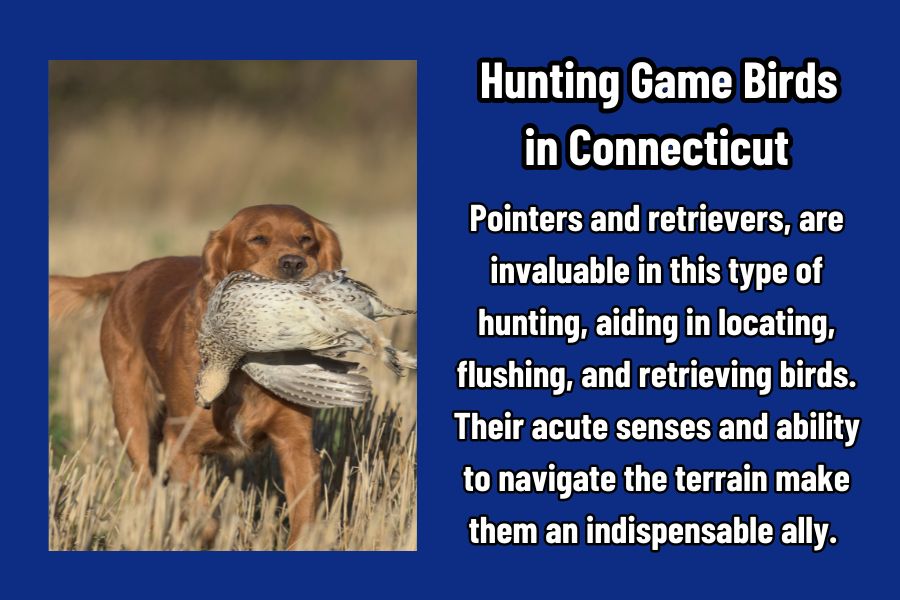
Upland game bird hunting in Connecticut provides a vibrant mix of habitats and seasons, offering hunters a chance to engage with nature’s best bird species. These birds, ranging from the elusive woodcock to the robust turkey, inhabit diverse environments across the state. Dogs, particularly pointers and retrievers, are invaluable in this type of hunting, aiding in locating, flushing, and retrieving birds. Bird dog hunting in Connecticut is a long standing tradition.
Hunting Partridge in Connecticut
The chukar and Hungarian partridge, introduced species in Connecticut, offer unique hunting experiences in grassland and open agricultural areas. Their seasons typically run from late September to late November. These birds are known for their fast, low flights, challenging hunters and dogs alike. Dogs are particularly useful in partridge hunting, flushing the birds from cover and retrieving them post-shot. The partridge’s elusive nature and quick flight patterns make them a thrilling target for upland game hunters.
Hunting Ruffled Grouse in Connecticut
The ruffled grouse, with its camouflage plumage and sudden, thunderous takeoffs, provides a heart-pounding hunt in the wooded areas of Connecticut. The season usually extends from late September to late December. Hunting these birds requires a keen eye and quick reflexes, with dogs playing a crucial role in locating and flushing them from dense underbrush, making every encounter a memorable challenge.
Hunting Quail in Connecticut
Quail hunting in Connecticut, focusing on the bobwhite quail, occurs in brushy, field-edge habitats where these birds are most commonly found. The season typically spans from late October to late November. Dogs are essential in quail hunting, using their scenting abilities to find these small, ground-dwelling birds and flush them into the open, providing hunters with the opportunity for a shot.
Hunting Woodcock in Connecticut
The American woodcock, known for its erratic flight and cryptic coloration, frequents the wet, brushy areas of Connecticut. Their hunting season, often in October, aligns with their migratory patterns. Woodcock hunting is a silent, stealthy pursuit, greatly enhanced by the use of dogs to locate and flush these birds, offering an immersive experience in the bird’s natural habitat.
Hunting Snipe in Connecticut
Snipe hunting, a test of true marksmanship and patience, takes place in marshy and muddy areas where these birds are found. The season usually falls in the cooler months, providing hunters with a challenging pursuit. Dogs are particularly useful in snipe hunting, finding and flushing the birds for hunters in the challenging terrain.
Hunting Rails in Connecticut
Rail birds, inhabiting Connecticut’s marshlands, offer a unique hunting experience, typically from September to November. Hunting rails is often done from a small boat, with dogs used to flush or retrieve birds from the thick reeds, adding an aquatic element to the upland hunting experience.
Hunting Crow in Connecticut
Crow hunting in Connecticut, allowed year-round with certain restrictions, is less about the game and more about wildlife management and skill. No bag limits apply, but hunters must follow specific regulations. While dogs are not traditionally used for crow hunting, they can assist in retrieving downed birds, adding to the efficiency of the hunt.
Hunting Turkey in Connecticut
Turkey hunting is a popular and regulated activity in Connecticut, with specific spring and fall seasons. These large, wary birds require stealth and patience to hunt, with dogs allowed during the fall season only on private lands to flush turkeys from their roosting areas. The interaction between hunter, dog, and turkey creates a dynamic and rewarding hunting experience.
Hunting Waterfowl in Connecticut
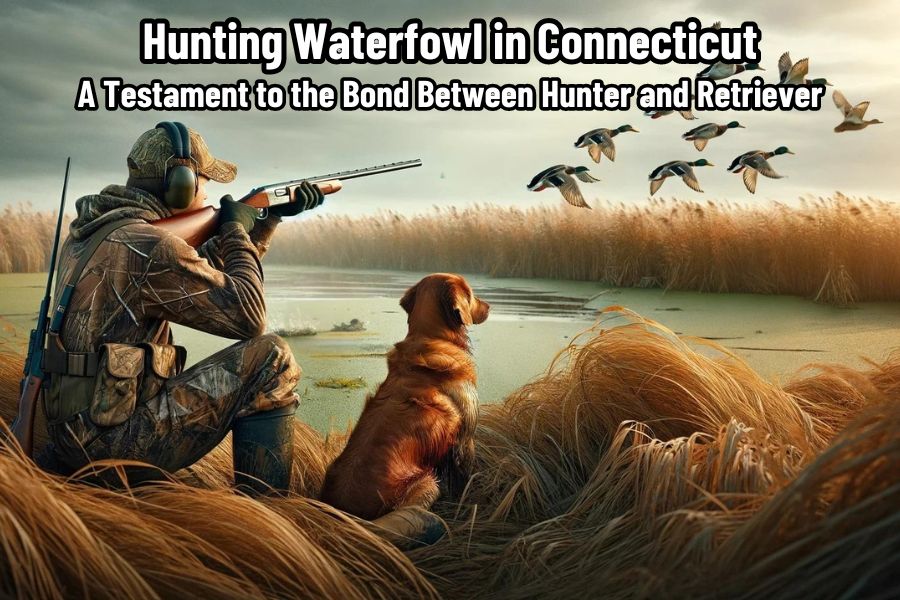
Hunting waterfowl in Connecticut is a cherished tradition, with the state’s abundant lakes, rivers, and coastal marshes providing ideal habitats for various waterfowl species. The experience is enriched by the crisp air of dawn, the quiet lapping of water, and the anticipation of the hunt. Dogs, particularly retrievers, are integral to waterfowl hunting, excelling in water retrieves and aiding hunters in locating downed birds. Their training and instincts are pivotal in navigating the watery terrain and recovering game efficiently.
Hunting Ducks in Connecticut
Duck hunting in Connecticut is a popular pursuit, with the state hosting several species like the mallard, wood duck, and black duck. The season typically runs from early October to January, depending on the zone. Hunters need a state license, a Federal Duck Stamp, and must adhere to bag limits. The wetlands and coastal areas, where ducks are abundant, become stages for the silent wait and sudden action of duck hunting. Retrieving dogs are especially valued for this type of hunting. Their water-loving nature and soft mouths are perfect for retrieving ducks without damaging them, making every hunt a testament to the bond between hunter and canine.
Hunting Goose in Connecticut
Goose hunting, targeting primarily Canada geese, is another favored activity, with seasons generally in the fall and winter months. These large birds require strategic planning and decoy setups to hunt successfully. Licenses and a Connecticut Migratory Bird Conservation Stamp are necessary, along with adherence to specific hunting regulations. Dogs play a crucial role in goose hunting, often braving cold waters to retrieve game. Their skills and resilience are as impressive to witness as the flight of a well-formed V of geese overhead.
Hunting Coot in Connecticut
Coot hunting, while less known, is an exciting aspect of hunting with dogs in Connecticut. Coots, often found in the same habitats as ducks, provide unique hunting opportunities, particularly from late October to January. Though not as popular as other waterfowl, coots require similar licensing and adhere to bag limits. Dogs are invaluable in coot hunting, adeptly retrieving from muddy waters and thick vegetation, showcasing their versatility and importance in waterfowl hunting. The experience of hunting coot adds a distinctive chapter to the hunter’s waterfowl story in Connecticut.
Hunter Education in Connecticut
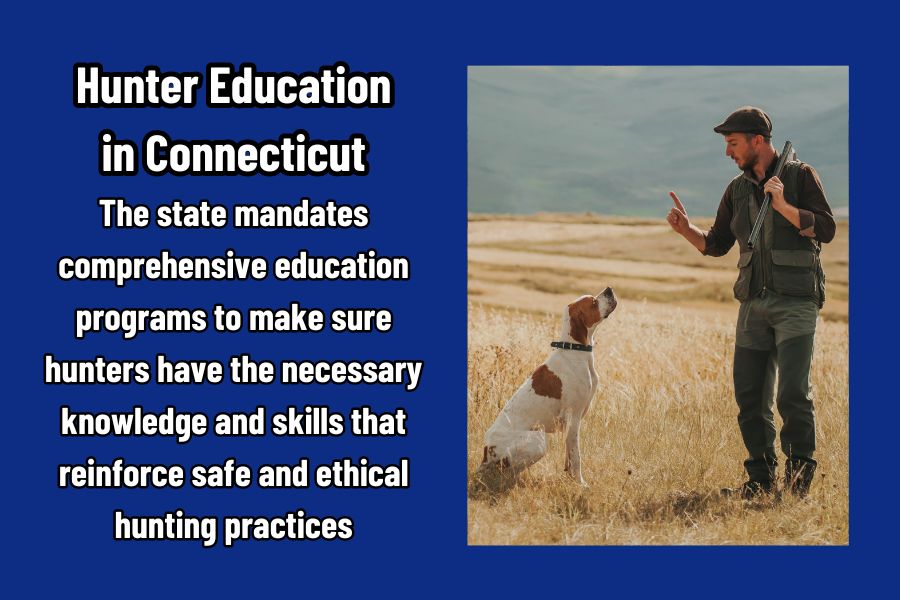
In Connecticut, ensuring that hunters are well-educated and responsible in their practices is paramount, especially when hunting with dogs in Connecticut. The state mandates comprehensive education programs, tailored to ensure hunters have the necessary knowledge and skills that reinforce safe and ethical hunting practices.
Hunter Education Requirements
To obtain a hunting or trapping license in Connecticut, individuals must demonstrate their competency through previous experience or formal education. This means showing evidence of a resident license held within the past five years or presenting a certificate from a recognized Connecticut Conservation Education/Firearms Safety (CE/FS) course. This requirement underlines the state’s commitment to maintaining high standards of hunting safety and conservation. Completing the course ensures that each hunter, and their canine companion, are well-prepared for the field.
Wild Turkey Hunting Seminar
For those keen on mastering turkey hunting, Connecticut offers specialized seminars that cater to both novices and seasoned hunters. These sessions delve into safe hunting practices, equipment nuances, and effective strategies for turkey hunting, including the role of dogs. The seminar also features practical exercises like shotgun patterning, providing hunters with a hands-on experience to refine their overall hunting skills.
Waterfowl Hunting Seminar
The Connecticut Waterfowl Association (CWA) sponsors seminars aimed at enhancing the skills of waterfowl hunters. These sessions cover a gamut of topics, from decoy placement and bird biology to shooting accuracy and calling techniques. A significant emphasis is placed on the synergy between hunter and dog, exploring how dogs can amplify the hunting experience through their retrieval and tracking abilities, crucial for successful waterfowl hunting.
Small Game Hunting Clinic
Connecticut’s small game hunting clinic is designed to spotlight this varied and exciting hunting form. Participants learn about the habitats, behaviors, and effective hunting methods for small game including dog assisted hunting. The clinic also offers practical advice on game care and preparation.
Wrapping Up the Hunt
As we conclude our journey through the ins and outs of hunting with dogs in Connecticut, it’s clear this tradition is more than a pastime—it’s a way of life. We’ve explored the varied game species, from the elusive whitetail deer to the swift-flying waterfowl, each offering unique challenges and rewards. The integral role of our canine companions, from tracking and flushing to retrieving, underscores the camaraderie and partnership inherent in this age-old practice.
You might be sitting there, reflecting on past hunts, or maybe you’re itching to experience your first trek through Connecticut’s diverse landscapes. It’s that mix of anticipation and nostalgia, isn’t it? That excitement of waking up before dawn, the weight of your gear, the eager panting of your dog by your side—these are the moments that define hunting in Connecticut with dogs.
Now, armed with knowledge about seasons, regulations, and the vital role of dogs, you’re ready to take the next step. Whether you’re mapping out a strategy for your first hunt or planning your return to familiar woods, the trails of Connecticut await. So, gather your gear, prep your loyal dog, and set out on a hunting adventure that promises not just game, but a deeper connection with the natural beauty of Connecticut. Happy hunting!
FAQs – Hunting with Dogs In Connecticut
What is the Connecticut Conservation ID Number?
Hunting with Dogs in Connecticut Answer:
In Connecticut, every licensed hunter receives a unique Conservation ID Number, a key identifier for purchasing licenses and permits annually. Whether online or at a vendor, your Conservation ID Number serves as your primary identifier. It’s wise to note down this number and keep it secure, as it acts as your gateway to Connecticut’s hunting realms, streamlining your licensing processes and ensuring you’re set for the season.
What is the Connecticut Hunter Harassment Law?
Hunting with Dogs in Connecticut Answer:
Encountering harassment while hunting can be challenging, but Connecticut’s hunter harassment law stands to protect sportsmen’s rights. It’s crucial to remain calm and collected in such situations. Should you face harassment, maintain a positive demeanor, and avoid confrontation. To build a robust case, if needed, document the incident carefully by noting the harassers’ actions and descriptions, recording vehicle license numbers, and abstaining from retaliatory violence. This law underscores Connecticut’s commitment to safeguarding the hunting experience.
When and where can you hunt turkey with dogs?
Hunting with Dogs in Connecticut Answer:
In Connecticut, turkey hunting with dogs is permitted only during the fall firearms season and exclusively on private land. This specific timeframe and location requirement reflects the state’s careful regulation of turkey hunting, balancing tradition with conservation efforts.
Can You Hunt Deer in Connecticut with Dogs?
Hunting with Dogs in Connecticut Answer:
Hunting in Connecticut with dogs for deer is prohibited. This rule is in place to ensure ethical hunting practices, prioritizing fair chase principles and the well-being of the deer population, maintaining the balance between hunting traditions and wildlife conservation.
Can You Hunt Small Game, Upland Game Birds, Waterfowl, and Furbearers in Connecticut with Dogs?
Hunting with Dogs in Connecticut Answer:
Yes, in Connecticut, dogs are invaluable partners in hunting small game, upland birds, waterfowl, and furbearers. They excel in tasks like chasing, retrieving, and flushing game. However, turkey hunting with dogs is an exception, allowed only during the fall firearms season on private property, illustrating the nuanced regulations governing dog-assisted hunting in the state.
Can you use duck blinds and decoys in Connecticut?
Hunting with Dogs in Connecticut Answer:
Using duck blinds and decoys is a common and effective strategy in Connecticut for waterfowl hunting. These tools are essential for concealing hunters and attracting birds within range, enhancing the hunting experience. Hunters must ensure they adhere to state regulations regarding the placement and use of blinds and decoys, aligning with ethical hunting practices and habitat preservation.
Resources
SPECIAL NOTE: The regulations, license information, best practices, species, and other key information provided in this post are based on research using the Resources listed below. The information provided is subject to change without notice. Therefore all hunters should always verify current information published by the Connecticut State Department of Energy & Environmental Protection.
- eRegulations – Hunting Laws & Regulations
- eRegulations – Department of Environmental Protection Hunting Dogs Training
- eRegulations – Game Bird Hunting
- eRegulations – Wild Turkey Hunting
- CT.GOV – CT Hunting and Trapping
- CT.GOV – 2024 Connecticut Hunting and Trapping Guide Webpage
- CT.GOV – 2024 Connecticut Hunting and Trapping Guide PDF
- CT.GOV – Hunting and Trapping Information
- CT.GOV – Conservation Education/Firearms Safety Program
- CT.GOV – Hunting Roadmap
- CT.GOV – Connecticut Hunter Education
- CT.GOV – Connecticut Hunter Safety Manual
- CT.GOV – Connecticut has a Hunter Harassment Law
Start planning your trip to go hunting with dogs in Connecticut. Also check out our other posts about hunting with dogs in…
Alabama
Alaska
Arizona
Arkansas
California
Colorado

